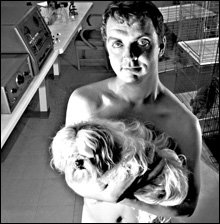
“LA VIE D’UN CHIEN:” John Harden’s short film succeeds as raucous comedy, as a cinéma-vérité send-up, and as an homage to human libido and canine sensitivity.
|
Not every serving in “Going Ape” tastes like dessert. In John Harden’s 13-minute black-and-white film “La vie d’un chien” (“The Life of a Dog”), a young scientist discovers a serum that temporarily allows people to assume canine form. Experimenting first on himself, the protagonist consummates his love for his pet Pekingese, Sylvie, making her man’s best friend in a whole new way. When he shares the formula of his discovery over the Internet, groups of otherwise decorous citizens take to the streets at night to run in packs, sniff under one another’s tails, hump, and chase cars. The authorities, of course, are alarmed, and the scientist is made to come up with an antidote, but the one he creates locks people into their doggy bodies. In the closing moments, Sylvie and our protagonist as mutt disappear into the darkness of a Paris street. Done in the style of a Ken Burns documentary with voiceovers and photo stills, “La vie d’un chien” succeeds at multiple levels — as raucous comedy, as a send-up of cinéma-vérité, and as an homage to both human libido and canine sensitivity.
The same can’t be said of the two other films, Mary Kenny’s humorless and didactic animations, “The Hunt” and “Death Down Under.” Both are less than four minutes long and done in the flatfooted style of Gumby. In one, an Eskimo seal hunter gets eaten by a polar bear; in the other, an aboriginal bird hunter gets eaten by a crocodile. And there’s about that much suspense. Maybe I’m just deaf and blind to an æsthetic that prizes technical naïveté and heavy doses of message bearing. (The seal hunter has just slaughtered his prey when the polar bear shows up; the bird hunter has just downed a heron when the croc enacts nature’s revenge.)
Henry Horenstein is among the last unflinching Romantics working in photography, and his inclusion in “Going Ape” is one of the quiet highlights of the show. Ten platinum prints from his 1995-’99 “Aquatics” series grace the second-floor gallery, and as often as I’ve seen them over the years they continue to enchant with their orchestrated marriage of dreaminess and precision. In one, the graceful tail of a beluga whale undulates vertically in cloudy water; in another, the misty face of a harbor seal pokes bashfully into the camera’s focus. In Texas Map Turtle we see the entire creature from its underside as it clamors with its pointed nose to the water’s surface for air. And it’s not just the sepia tones of his images or the measured balance of his compositional style that gives Horenstein’s photos their Old World, 19th-century appeal. His photography is rooted in the medium’s origins: painting. Every detail — air bubble, whisker, play of light — reflects the artist’s engaged decision making. If the emotional range is limited (a good-humored eeriness prevails), candor and harmony and charm still make his work indelible.
‘Going Ape: Confronting Animals In Contemporary Art’ | DeCordova Museum and Sculpture Park | 51 Sandy Pond Road, Lincoln | Through January 7
ADVERTISEMENT
 |